#shrimad bhagvatam
Text

🪷🦚˚∗:𝙊𝙣 𝙩𝙝𝙚 𝙥𝙧𝙚𝙩𝙚𝙭𝙩 𝙤𝙛 𝙩𝙝𝙚 𝙥𝙧𝙤𝙘𝙚𝙨𝙨𝙞𝙤𝙣, 𝙍𝙪𝙠𝙢𝙞𝙣𝙞 𝙙𝙞𝙨𝙥𝙡𝙖𝙮𝙚𝙙 𝙝𝙚𝙧 𝙗𝙚𝙖𝙪𝙩𝙮 𝙛𝙤𝙧 𝙆𝙧𝙞𝙨𝙝𝙣𝙖 𝙖𝙡𝙤𝙣𝙚. 𝙎𝙡𝙤𝙬𝙡𝙮 𝙨𝙝𝙚 𝙖𝙙𝙫𝙖𝙣𝙘𝙚𝙙 𝙩𝙝𝙚 𝙩𝙬𝙤 𝙢𝙤𝙫𝙞𝙣𝙜 𝙡𝙤𝙩𝙪𝙨 𝙬𝙝𝙤𝙧𝙡𝙨 𝙤𝙛 𝙝𝙚𝙧 𝙛𝙚𝙚𝙩, 𝙖𝙬𝙖𝙞𝙩𝙞𝙣𝙜 𝙩𝙝𝙚 𝙖𝙧𝙧𝙞𝙫𝙖𝙡 𝙤𝙛 𝙩𝙝𝙚 𝙇𝙤𝙧𝙙. 𝘼𝙩 𝙩𝙝𝙖𝙩 𝙢𝙤𝙢𝙚𝙣𝙩 𝙨𝙝𝙚 𝙨𝙖𝙬 𝙆𝙧𝙞𝙨𝙝𝙣𝙖. 𝙏𝙝𝙚𝙣 𝙬𝙝𝙞𝙡𝙚 𝙝𝙞𝙨 𝙚𝙣𝙚𝙢𝙞𝙚𝙨 𝙡𝙤𝙤𝙠𝙚𝙙 𝙤𝙣 𝙩𝙝𝙚 𝙡𝙤𝙧𝙙 𝙨𝙚𝙞𝙯𝙚𝙙 𝙩𝙝𝙚 𝙥𝙧𝙞𝙣𝙘𝙚𝙨𝙨 𝙬𝙝𝙤 𝙬𝙖𝙨 𝙚𝙖𝙜𝙚𝙧 𝙩𝙤 𝙢𝙤𝙪𝙣𝙩 𝙝𝙞𝙨 𝙘𝙝𝙖𝙧𝙞𝙤𝙩. 𝙇𝙞𝙛𝙩𝙞𝙣𝙜 𝙩𝙝𝙚 𝙥𝙧𝙞𝙣𝙘𝙚𝙨𝙨 𝙤𝙣𝙩𝙤 𝙝𝙞𝙨 𝙘𝙝𝙖𝙧𝙞𝙤𝙩, 𝙬𝙝𝙤𝙨𝙚 𝙛𝙡𝙖𝙜 𝙗𝙤𝙧𝙚 𝙩𝙝𝙚 𝙚𝙢𝙗𝙡𝙚𝙢 𝙤𝙛 𝙂𝙖𝙧𝙪𝙙𝙖, 𝙇𝙤𝙧𝙙 𝙈𝙖𝙙𝙝𝙖𝙫𝙖 𝙙𝙧𝙤𝙫𝙚 𝙗𝙖𝙘𝙠 𝙩𝙤 𝙩𝙝𝙚 𝙘𝙞𝙧𝙘𝙡𝙚 𝙤𝙛 𝙠𝙞𝙣𝙜𝙨. 𝙒𝙞𝙩𝙝 𝙗𝙖𝙡𝙖𝙧𝙖𝙢 𝙞𝙣 𝙩𝙝𝙚 𝙡𝙚𝙖𝙙, 𝙝𝙚 𝙨𝙡𝙤𝙬𝙡𝙮 𝙚𝙭𝙞𝙩𝙚𝙙, 𝙡𝙞𝙠𝙚 𝙖 𝙡𝙞𝙤𝙣 𝙧𝙚𝙢𝙤𝙫𝙞𝙣𝙜 𝙝𝙞𝙨 𝙥𝙧𝙚𝙮 𝙛𝙧𝙤𝙢 𝙩𝙝𝙚 𝙢𝙞𝙙𝙨𝙩 𝙤𝙛 𝙟𝙖𝙘𝙠𝙖𝙡𝙨˚∗: 🦚🪷
Source: Shrimad Bhagvatam Canto 10, chap 53
SUBH RUKMINI HARAN EKADASHI🪷
Rakhumai Rakhumai💗💗
#subh rukmini haran ekadashi#krishmini#rukmini#hindublr#hinduism#devotion#gopiblr#gopi#krishnablr#krishna#kanha#desiblr#why am i always late#kanhaiya#rukminikrishna#rakhumai rakhumai#dwarka
117 notes
·
View notes
Text
I’ve begun listening to Amarendra Prabhu, Indresh Updhyay, Chitralekha ji, Jaya Kishori ji narrating Shrimad Bhagvatam after a long time. Life’s good again.
Radhe Radhe 🦚💛
8 notes
·
View notes
Text
The Yadava Curse
A/N: Before reading this I feel the need to warn you that this ends sadly. Also, it’s my first time making a header/moodboard, go easy on me! Crossposted on AO3: https://archiveofourown.org/works/25838302
Hindu Mytho Event: Day 2 Canon Divergence & Day 3 Female Characters

In hindsight, Rukmini convinced herself that it was better that her son be the one to cause the strife. Pradyumna grew up too quickly, always wanting to be at his father’s side, ready to fight or reason regardless of whether two states were at war or two brothers fighting over the last mango. Rukmini spent any free time she had worrying about her son who never played pranks, never caused her any worry. He, luckily, hadn’t inherited that from his father. He showed too much of an interest in her work even at a tender age, though, she reckoned, that was partially her fault. She had sat in the Dwarka Yadava council right up until she gave birth, and even after, nursing him while court was in session, much to the chagrin of all the elders. (What could they say? Chief wife of Narayan Shri Krishna, Lakshmi on Earth? She held the power. Pradyumna would stay.)
So when Samba, he, of course, would be the troublemaker of all the Yadava kids, took him to the lower city to “rakhad,” she was more than overjoyed, though she wouldn’t show it. She had a reputation to maintain.
She could remember it vividly, Samba running up to her, Pradyumna in tow, “Can we go into the lower city Badi maa?”
“Kyun?”
“Bas aise! Rakhad ne ke liye!”
She hadn’t thought anything of it, “Of course beta! Take the guards with you!”
But what Samba had proposed next had been a surprise, “Nahi Badimaa! Not with guards! In disguise!”
Rukmini had glanced up sharply, ready to turn that idea down but Samba cut her off, “Pitaji used to go! He still tries to go, but everyone recognizes his Gopala disguise...”
She hid a smile; the younger boy was right, and more observant than she was aware. Krishna tended to step out from time to time, disguised in a getup from his childhood days. Both Pradyumna and Samba, though, had taken after their mothers in looks, not her husband; they would be unnoticed.
“Accha fine, but be careful!” With a quick smile and a rushed hug, Samba had run off, tugging Pradyumna along, her next words falling on deaf ears, “And no disturbing the rushis near the temple grounds!”
Rukmini had warned them. She had. Regardless of what the other raanis had said, she had warned the sons. But the curse was set. She never heard the full story, all she knew was: Pradyumna dressed as a pregnant woman, Samba’s mace under his angavastram, and a prank that went very wrong. She had seen her son after, face ashen and eyes red from crying. She had hugged him and comforted him as he clutched her like a newborn baby. She had heard him choke out that it was his fault that he had play acted, his fault that the sages were angered at his prank, and his fault that their family was doomed to death. She had held him tightly, wiping his tears, shushing him until he stopped sniffling. Samba and Jambavati had joined them in her chambers, the three of them worrying and crying, while she comforted and quieted them until her husband came back.
When Krishna came home, Pradyumna, though almost 18, had rushed into his father’s embrace, sobbing openly, soaking the Pitambar in tears. Krishna had just laughed, sitting him down. “Beta, wipe your tears. What happened, has happened. Why worry about something you no longer have control over?”
And that had been that. He was Narayan, and she was Lakshmi, but even they had no sway on destiny, no one did.
On the orders of the council, the mace had been ground up into ashes and thrown into the ocean, the clothes burned, the incident forgotten. But Rukmini never forgot. It wasn’t in her nature. She remembered everything for years and years, and waited calmly until the day that Krishna left one last time, the day of the family picnic. He had held her tightly, too tightly. He had kissed her deeply, too deeply. He had whispered the words, “I’ll see you in Vaikunta.” And then he had left, never to be seen by her in those eyes again. With a sinking feeling, she had gotten ready for the picnic, ready for her death.
She remembered it all, the merriment among the Yadava clan, the plentiful food, the joyful music and especially the overflowing wine. She remembered how a provoking word had been said by someone unimportant, and she remembered how the wine turned family against family, their own civil war. She remembered watching as the rest of the Ashtabharya also took up arms, Satyabhama in her element, fiery sword slashing this way and that. She remembered walking away from the carnage to her own chariot. She would not die this way.
She had caught the reins herself, urging the horses forward as she ruminated in her thoughts. Yes. It was a good thing that Pradyumna at least lived and pranked once, even though it was disastrous. Yes. It was good that he had been free if only for a moment. She would miss him; her son, another form of Narayana.
She made her way to the cliff she had decided would be her final step on Earth. It was far enough away that she could not see the bloodshed, but close enough to hear it. She had delayed it as long as she could, taking in her surroundings. She had let her horses go, the creatures could not be bound to a chariot for long, and then she was truly alone.
The sea, her father in another lifetime, was dark, reflecting the sky above. How quickly the skies had turned cloudy and dark. Not hours ago they had painted a different picture entirely. She felt a deep sadness, loneliness, she truly would die alone in this life. And then she remembered something Krishna had told her. Mata Yashoda had said that her Shyam would never leave her as long as the skies still turned dark. Rukmini looked up once more, at the skies and thought of her Shyam, her Krishna, her Narayan. She walked up, right to the edge of the cliff, eyes not leaving the sky, finding Shyam in every last shadow and movement of the clouds. She saw his arms reach out to her, beckoning her forward into the clouds. And then, still looking up, still thinking of her Krishna, she took the last step off the cliff, plunging into the depths below.
As she fell, she thought not of Pradyumna, Samba and the rest of her family, dying and decaying on the beach nearby. She thought not of the circumstances that lead her here, the mace, the prank, destiny’s revenge. She thought only of her Shyam, her Krishna. Ashes to ashes, dust to dust. In the same way, she would return, the Lakshmi to her Narayan, reunited once again.

A/N (again): This is for the @hindumythologyevent! I wanted to take part in day 1, but my modern au just isn’t up to par yet! I’ll try to keep up with as many events as possible, keeping in mind that it is Shyam’s birthday in one/two days so I will be writing for him and also that I write like a snail on here! Anyways, I ramble! Let me know what you think!
Tagging some mutuals and fellow desiblrs I love: @lovingyou-is (Special shoutout to you, K, for helping me make my header/moodboard!) @incurablescribbler @soniaoutloud @chaanv @1nsaankahanhai-bkr @allegoriesinmediasres @mayavanavihariniharini @heyifinallyhaveablog @worddiva179 @supermeh-krishnafan @bigheadedgirlwithbigdreams @ariouseok @iamnotthat @shaonharryandpannisim @will-die-without-chai @sthitivinasha @jeyaam @dilkishehnaai (A, I know you aren't really into the mytho side of desiblr, but I love you, so enjoy!)
#hindumythologyevent#my shyam my madhav#lord krishna#krishna#Shri krishna#rukmini#hindu mythology#hindu god#day 2: canon divergence#day 3: women in legends#mahabharata#mahabharat#shrimad bhagvatam#triveni writes#my writing
48 notes
·
View notes
Text
Guru Poornima Images
The day of full moon, Purnima, in the long stretch of Ashadh is customarily celebrated as Guru Purnima by Hindus. Otherwise called Vyas Purnima, the day is praised in recognition and love to sage Ved Vyas. He is the Adi (unique) Guru of the Hindu Dharma, who arranged the Vedas, composed the eighteen Puranas and the Mahabharat. On this day, the Guru is offered Pujan (worship)by the followers. First we will think about the job of a Guru throughout everyday life.
The Need of a Guru
The Sanskrit root "Gu" signifies murkiness or obliviousness. "Ru" means the remover of that haziness. In this manner one who expels haziness of our numbness is a Guru. Just he who evacuates our definitive murkiness, known as Maya, and who rouses and directs us on to the way of God-acknowledgment is the genuine Guru. Understudies likewise allude to their teacher or school speaker as master. The meaning of the word master for this situation is one who bestows transient information (Apara Vidya) and is along these lines in like manner offered regard.
An otherworldly competitor, regardless of how splendid, can never accomplish such information by his own undertaking. This is specified in the Shrimad Bhagwatam in which Jadbharat uncovers to lord Rahugan:
"O Rahugan! One can't accomplish information on Atma and Paramatma by performing compensation, penances, renunciation, Vedic examination or venerating divinities of water, fire or the sun. Be that as it may, when the residue from the feet of a satpurush (God-acknowledged Guru) sprinkles on our heads, at that point we can unquestionably achieve this information."
Fundamentally, one can just accomplish salvation by serving the satpurush. Stepping the way to God-acknowledgment independently is compared by the Katha Upanishad as strolling on a razor's edge. Adi Shankaracharya echoes a comparative order: "If an individual, in spite of having: an attractive, malady free body, acclaim, a heap of riches, and regardless of whether he has examined the Vedas and every single other sacred writing, and has himself made numerous sacred writings, yet has not given up himself at the feet of a Guru, at that point he has accomplished nothing, nothing, nothing, nothing."
The Guru assumes an essential job in boosting the applicant as often as possible, when he loses track, gets down and out or basically comes up short on steam. The applicant is in this manner better ready to comply with the Guru in the event that he comprehends the Guru's magnificence.
Wonder of the Guru
The Hindu shastras have hailed such a Guru limitlessly:
Skanda Purana - Guru Gita
A well known section known by heart by every Hindu youngster commends the Guru:
Gurubrahma Guruvishnu Gururdevo Maheshwaraha |
Guruhu sakshaat Parambrahman tasmai Shrigurave namaha ||
"The master is Brahma, Vishnu and Mahesh (Shiva), love to the Guru who is Parabrahman show."
The second line of the couplet doesn't actually imply that the Guru becomes Parabrahman - God, rather he is loved as though God is showing through him.
This is unobtrusively outlined by another well known stanza known to all Hindus:
Master Govind donu khade, kisko laagu paay,
Balihari Gurudevaki jinhe Govind diyo bataay.
The Guru and Govind - God, are available before me, to whom will I bow down first? Brilliance to the Guru since he demonstrated me Govind.
Aside from directing the hopeful on the way to God-acknowledgment, the Guru illuminates the significant implications of the huge range of scriptural information. Thus the Mundaka Upanishad calls such a Guru "Shrotriya" - knower of the genuine implications of the sacred texts. Adi Shankaracharya disallows a wannabe in attempting to decode the implications without a Guru. In his editorial on a Mantra (1/2/13) of the Mundaka Upanishad, he says: "Regardless of whether one has information on the sacred texts, he ought not endeavor to dive into their implications without anyone else. He ought to acquire the information on Brahman just through the Guru."
In their compositions, different Acharyas, for example, Ramanuj and Nimbark have considered the Guru compulsory in God-acknowledgment.
The Guru in the Swaminarayan Sampradaya
As per the directives from shastras of Hindu Dharma refered to above, Bhagwan Swaminarayan too thinks about the Guru as first; to be adored as one reveres God. In His Vachanamrutam He utilizes the terms Sadhu and Satpurush equivalently for the genuine Guru.
Gadhada III.27:
"The sacred texts advocate five characteristics of: Nishkam, Nirlobh, Nirman, Niswad and Nisneha for a sadhu. The sadhu in whom one watches such traits has a steady compatibility with God. In this manner one should have permanent confidence in his words, and by his words ought to understand the information on God."
Gadhada III.26:
"The sadhu who lives in a manner by which he quells his indriyas and antahkaran, however isn't stifled by them, who takes part in God-related exercises just, carefully watches the Panch Vartamans, trusts himself as being Brahman and loves Lord Purushottam, can be referred to neither as a person nor a deva, since neither man nor deva have such characteristics. Subsequently such a sadhu, however an individual, has the right to be adored at standard with God."
At last, in what capacity should a competitor serve such a Guru?
Serving the Guru
Again the sacred writings control the wannabe:
(1) Shvetashvatara Upanishad (6/23) :
Backers love to the Guru in a similar way as the god - God, to accomplish everything to achieve on the way of God-acknowledgment:
Yasya deve para bhaktir yatha deve tatha gurau |
Tasyaite kathitaa greetings arthaaha prakashante mahatmanaha ||
(2) Bhagavad Gita (4/34) :
The pupil ought to submissively suggest conversation starters to the Guru and please him by serving him. He will at that point confer the information on God, so appoint the savvy sages.
(3) Shrimad Bhagvatam :
Bhagwan Rushabhdeva advocates his children: Obeying the Anuvrutti - unvoiced wishes - of God and Guru is dedication.
(4 ) Vachanamrutam (Vadtal 5) :
The applicant should offer equivalent and strongly cherishing administration to God and His sadhu. At that point, in spite of being the most minimal kind of aficionado who is bound to turn into an incredible fan after either two births or four births or ten births or even a hundred births, he can turn into an extraordinary enthusiast in this birth. Such is the product of serving God and His sadhu similarly."
The expression "extraordinary aficionado" means moksha-salvation.
Subsequently upon the arrival of Guru Purnima, supporters introspect, and resolve to offer pujan and worship to the Guru as a top priority, activity and discourse; verifiably comply with his unvoiced wishes, orders, serving him as one would God and praising his brilliance and redemptive qualities.
Consistently, the Guru Purnima Festival, within the sight of Pramukh Swami Maharaj is commended with commitment and eagerness at Bochasan Mandir. A get together from 8.30 am to 12.00 early afternoon is held wherein bhajans and talks by senior sadhus accentuate and sing the magnificence of the Guru. The celebration is at last delegated with Swamishri's favors and darshan - where thousands offer their respect by documenting past Swamishri.
1 note
·
View note
Text
Navratri - a nine day festival dedicated to Mother Goddess Durga
source
The word Navaratri literally means nine nights in Sanskrit, nava meaning nine and ratri meaning nights. During these nine nights and ten days, nine forms of Shakti / Devi are worshiped.
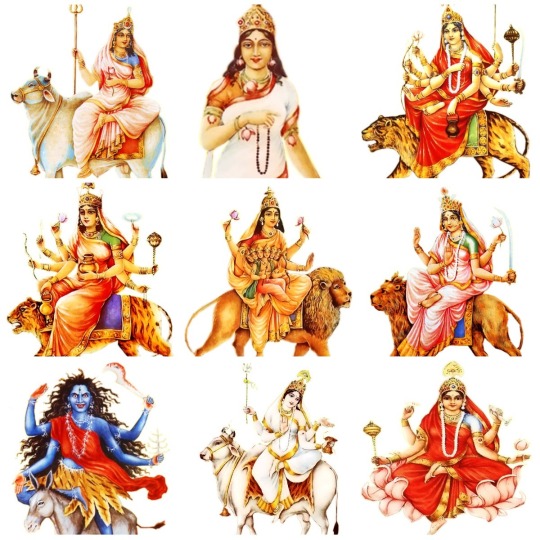
The seeds of inner renewal are sown, sprouting, watched & worshiped by devotees during Navratri and on the 8th, 9th and 10th days, Goddess Durga, Mahanavami and Vijayashtami are worshipped. The tenth day that is commonly referred to as Vijayadashami or "Dussehra", celebrates victory of Shakti over Mahishasura, of Lord Rama over Ravana, and of Durga over demons like Madhu-Kaitav, Chanda-Munda and Shumbha-Nishumbha; that is victory of good over evil.
The last 3 days of Navratri are called Durgashtami (8th day), Mahanavami (9th day) and Vijayadasami (10th day). On the morning of the tenth day there is a fire ceremony dedicated to Shiva, where the Navaratri participants have a chance to receive Shiva's blessing.
The beginning of spring and the beginning of autumn are considered to be important junctions of climatic and solar influences. That is why these two periods are taken as sacred opportunities for the worship of the Divine Mother Durga. The dates of the festival are determined according to the lunar calendar.
Navratri is a very important and major festival in the western states of India: Gujarat, Maharashtra, and Karnataka during which the traditional dance of Gujarat called "Garba" is widely performed. This festival is celebrated with great zeal in North India as well, including Bihar, West Bengal, Madhya Pradesh and the northern state of Punjab.
Durga, the Mother Goddess of the Hindus and a form of Devi and Shakti, is believed to have manifested in various forms, and Navadurga Maa are believed to be the most sacred aspects of Goddess Durga.
According to a Hindu tradition, it is believed that there are three major forms in which Goddess Durga manifested herself, namely, Mahasaraswati, Mahalakshmi and Mahakali who are the active energies (Shakti) of Brahma, Vishnu and Rudra respectively (without these goddesses the gods will lose all their powers).
These three forms of Durga further manifested in three more forms each, and thus emerged the nine forms of Durga, which are collectively called Navadurga or Nine Durgas:
1. Devi Maa Shailputri - The Navratri commences with the 1st night devoted to the puja of Maa "Shailputri". "Shail" means mountains; "Parvati", the daughter of king of Mountains Himavan, is known as "Shailputri". Her 2 hands, display a trident and a lotus. She is mounted upon a bull.

2. Devi Maa Brahmacharini - One hand holds a "Kumbha" or water port and the other rosary. She personifies love and loyalty. Maa Brahmacharini is a store-house of knowledge and wisdom. Rudraksha is her most adorned ornament.
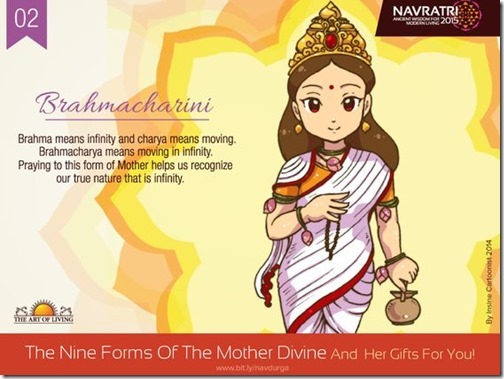
3. Devi Maa Chandraghanta - Worshipped on the 3rd night this Maa Durga "Shakti" is astride a tiger, displays a golden hue to Her skin, possesses ten hands and 3 eyes. Eight of Her hands display weapons while the remaining two are respectively in the mudras of gestures of boon giving and stopping harm. Chandra + Ghanta, meaning supreme bliss and knowledge, showering peace and serenity, like cool breeze in a moonlit night.

4. Devi Maa Kushmanda - The 4th night begins the worship of Maa "Kushmanda", possessed of eight arms, holding weapons and a mala or rosary. Her mount is a tiger and She emanates a solar like aura. "Kumbh Bhand" means to see cosmic vivacity in Pindi shape or knowledge of cosmic intricacies in human race. The abode of Maa "Kushmanda" is in Bhimaparvat.

5. Devi Maa Skandamata - Using a lion as a vehicle She holds her son, "Skand" in her lap while displaying 3 eyes and 4 hands; two hands hold lotuses while the other 2 hands respectively display defending and granting gestures. Its said, by the mercy of Maa "Skandmata", even the idiot becomes an ocean of knowledge such as "Kalidas".

6. Devi Maa Katyayani - As mother, Maa "Katyayani" stayed in the Ashram of sage Katyayan for penance, hence She named as "Katyayani". This 6th Shakti is also astride a lion with 3 eyes and 4 arms. One left hand holds a weapon and the other a lotus. The other 2 hands respectively display defending and granting gestures. Her complexion is golden coloured.
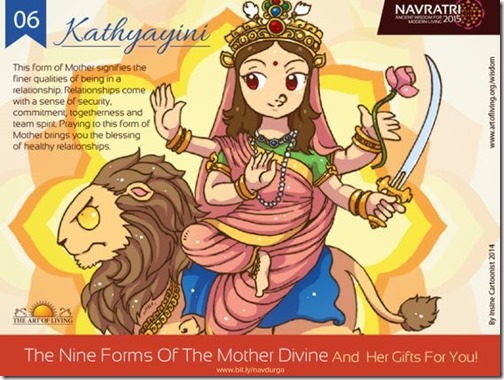
7. Devi Maa Kalaratri - Black skin with bountiful hair and 4 hands, 2 clutching a cleaver and a torch, while the remaining 2 are in the mudras of "giving" and "protecting". She is mounted upon a Donkey. The destroyer of darkness and ignorance, Maa "Kalaratri" is the seventh form of Nav-Durga meaning scourer of darkness; enemy of darkness. Maa Kalaratri's famous shrine is in Calcutta.
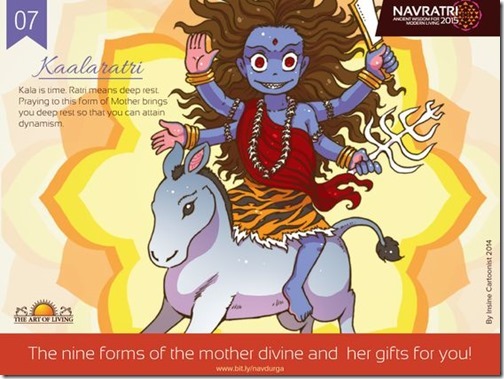
8. Devi Maa Mahagauri - Four arms with the fairest complexion of all the Durga Shaktis. Peace and compassion radiate from Her being and She is often dressed in a white or green sari. She holds a drum and a trident and is often depicted riding a bull. Maa "Mahagauri can be seen in a temple at Kankhal near pilgrim centre Haridwar.

9. Devi Maa Siddhidatri - Ensconced upon a lotus, most commonly, with 4 arms, and is the possessor of 26 different wishes to grant Her bhakts. Maa Siddhidatri's famous pilgrim centre, is located in Nanda Parvat in the Himalayas.

The nine manifestations of Maa Durga that are worshiped with fervor during Navratri, are believed to lift divine spirit in us to help us overcome obstacles and get liberated from unnecessary qualities to be filled with new freedom and purity.

All these nine names of Goddesses are decribed in "Devi Kavacha" of the Chandipatha scripture. Also called The Devi Mahatmyam or Devi Mahatmya ("Glory of the Goddess") it is a Hindu religious text describing the victory of the goddess Durga over the demon Mahishasura. As part of the Markandeya Purana, it is one of the Puranas or secondary Hindu scriptures, and was composed in Sanskrit around c. 400-500 CE, with authorship attributed to the sage (Rishi) Markandeya. Devi Mahatmyam is also known as the Durga Saptashati or Chandi Patha.
The other important work that focuses on veneration of the divine feminine is Devi Bhagavata Purana ("The Old Book of the Goddess"), also known as Shrimad Devi Bhagvatam or the Devi Bhagavatam.
#NAVRATRI#navaratri#9 goddes#Glory of the Goddess#durga#parvathi#parvati#lakshmi#hindu#hinduism#IHH Article
140 notes
·
View notes
Photo

Maa Shailputri è la prima delle nove forme della dea Durga venerate nelle Nove Notti di Durga. "Shail" significa montagna e "Putri" figlia, ma è anche conosciuta come Parvati o Hemavati, infatti è figlia del re delle montagne "Parvat Raj Himalaya". Shailputri è manifestazione del pianeta Terra. Cavalca il toro Vrisharuda, sorregge nelle due mani un fiore di loto e il Trishula. Essa predica la pace, avverte dei mali del mondo i suoi devoti, si adopera perché sia fatta giustizia, risveglia la spiritualità nei suoi devoti. Shailputri è la re-incarnazione di Sati, figlia di Daksha e di Prasuti incarnatasi per ordine del dio Brahma, il quale voleva dare una moglie devota a Shiva. Sati crebbe nella devozione e nell'amore per il dio Shiva, l'amore del Quale ottenne compiendo austere pratiche ascetiche. Sati si ritirò con il marito sul monte Kailash, a lui sacro. Un giorno il padre di Sati, Daksha, organizzò un "grande sacrificio"(Yajna) al quale invitò tutti gli dèi tranne la figlia ed il marito Shiva. Sati vi si recò comunque ed il padre Daksha l'accolse con freddezza. Nel corso della discussione che seguì il padre rivelò alla figlia che riteneva il matrimonio il suo matrimonio un disonore. Per la rabbia ed il dolore causato dall’ottusità paterna, Sati invocò i suoi poteri yogici e si auto-immolò nel fuoco. (Shrimad Devi Bhagvatam, capitolo XXX). Rinacque come Parvati (Shailputri) figlia del dio Himalaya. Shailputri cercò a lungo Shiva e solo dopo molti sforzi potè riposare nel suo amore universale. Shailputri risveglia lo spiritualismo nei suoi devoti ed illumina le loro anime. Dona a coloro che la meditano fiducia calma coraggio e consapevolezza. Rappresenta il primo passo verso la Madre Divina, siamo tutti noi che camminiamo verso l'Amore Divino. E' associata al Muladhara Chakra, il chakra della radice dove è custodita la Kundalini, l'energia di tutto ciò che deve essere ancora realizzato. Meditando il Muladhara Chakra si ottengono fiducia calma coraggio entusiasmo verso il cammino intrapreso. 🔱📿 #navaratri #chaitranavaratri #hinduism #sanathanadharma #durgamaa #shailaputri #shailaputridevi #muladharachakra #induismo #paganesimo #spiritualità #yoga (presso Bologna, Italy) https://www.instagram.com/p/CNlDF44qY4e/?igshid=yf6ujoeieecd
#navaratri#chaitranavaratri#hinduism#sanathanadharma#durgamaa#shailaputri#shailaputridevi#muladharachakra#induismo#paganesimo#spiritualità#yoga
0 notes
Photo

🕉 🚩 Prediction of Corona virus #COVID19 or wars economic slowdown etc is already predicted in Ancient Old Vedic Scripture Srimad Bhagvatam ...but we will not read it carefully. Before it is too late Start Reading Srimad Bhagvadgita as it is Srimad Bhagvatam now.... So that we can prevent all such disaster in Future. It is not just religious text but manual for human form of life Matchless Gift by God for us. Our ancient scriptures have already warned about such diseases due to atrocity on animals!!! _________________________________________ Shrimad Bhagvat Mahapuran (7.15.24) कृपया भूतजं दु:खं दैवं जह्यात्समाधिना । आत्मजं योगवीर्येण निद्रां सत्त्वनिषेवया ॥ २४ ॥ Translation By good behavior and freedom from envy one should counteract sufferings due to other living entities, by meditation in trance one should counteract sufferings due to providence, and by practicing haṭha-yoga, prāṇāyāma and so forth one should counteract sufferings due to the body and mind. Similarly, by developing the mode of goodness, especially in regard to eating, one should conquer sleep. Purport By practice, one should avoid eating in such a way that other living entities will be disturbed and suffer. Since I suffer when pinched or killed by others, I should not attempt to pinch or kill any other living entity. People do not know that because of killing innocent animals they themselves will have to suffer severe reactions from material nature. Any country where people indulge in unnecessary killing of animals will have to suffer from wars and pestilence imposed by material nature. Comparing one’s own suffering to the suffering of others, therefore, one should be kind to all living entities. One cannot avoid the sufferings inflicted by providence, and therefore when suffering comes one should fully absorb oneself in chanting the Hare Kṛṣṇa mantra. One can avoid sufferings from the body and mind by practicing mystic haṭha-yoga. #LostKnowledge #ancientteachings #Ancientculture #ancienthistory #instalike #vedas #backtoroots #Hinduism #indianrightwingcommunity #gocorona #covid_19 #incredibleindia #govegan (at গোৱালপাৰা) https://www.instagram.com/p/B-GkQn4lHwx/?igshid=175xcvyxwebhj
#covid19#lostknowledge#ancientteachings#ancientculture#ancienthistory#instalike#vedas#backtoroots#hinduism#indianrightwingcommunity#gocorona#covid_19#incredibleindia#govegan
0 notes
Photo

During the churning of the oceans, the first product that emerged - namely the hot and deadly poison named Halahala, which immediately began to torment the worlds. The frightened Devas wondered where to seek solace from this plight. They came to the realisation that Lord Shiva, with all those poisonous serpents entwined playfully about his body was the only one who could perhaps resolve their distress. Seeing their distress Lord Shiva was overwhelmed with compassion. Shiva then took the poison in his palm and held it in his throat. The same deadly venom that was threatening to end the worlds now became a beautiful ornament of Shiva, turning his throat a light blue, a monument to his supremely compassionate and sacrificing nature. "Compassionate ones generally undertake a lot of trouble to relieve others of their suffering. However, this is no pain at all, because relieving others of their suffering is the highest worship of god" Shrimad Bhagvatam. The emergence of poison as the first product of the churning indicates that obstacles inevitably come up whenever any good work is undertaken, whether they be in form of suffering or physical impediments blocking the goal. The bigger the job you set out to do, the stronger is the poison that will turn up. Those on the path of God do know that once they have set out on their way, the negative tendencies kama (lust), krodha (anger) lobha (greed) etc. start tormenting one with surprisingly strong vigour. Only the one, who like Lord Shiva, bearer of the Ganga of knowledge on his head can survive, they even come out stronger after encountering them. Therefore, whenever any bitter poison, be it in the form of suffering or a negative tendency, surfaces in our lives, it is to Lord Shiva we should look up to. "That which begins like poison, ends up like nectar (amrita); and that which at first seems like nectar ends up as poison" Bhagwat Geeta. ✨🕉🔱🐍💀🌿🌙👁📿🐚🌷🌀🔔🎨✨ Hari Om Tat Sat ~ Om Namah Shivaya ~ Jai Neelkanth Mahadev!! 🕉💖🙏 (at Forest Hills–71st Avenue) https://www.instagram.com/p/BzqDHbTj-bh/?igshid=2nnv0l8wcvow
0 notes
Photo
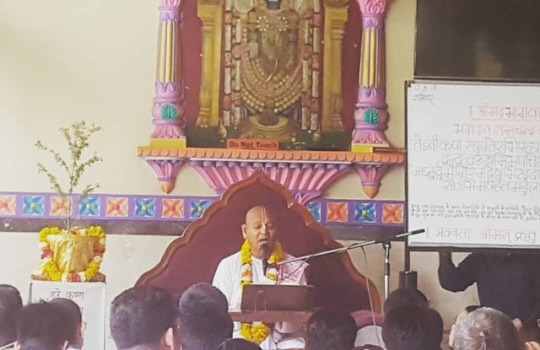
HH Kratu Das Ji Maharaj delivering morning shrimad bhagvatam class in @iskcon_punjabibagh. #agtsp #jayaprabhupada #harekrishna #kratuprabhu #kratudasjimaharaj #morningclass #shrimadbhagvatam #iskcon #iskconpunjabibagh #punjabibagh #haribol (at ISKCON Punjabi Bagh)
#iskconpunjabibagh#shrimadbhagvatam#punjabibagh#agtsp#kratudasjimaharaj#iskcon#morningclass#haribol#jayaprabhupada#harekrishna#kratuprabhu
0 notes
Link
User Views: 162 Amongst mundane scholars, there is some diversity of opinion as to the date of compilation of Srimad-Bhagavatam. It is, however, certain from the text of the Bhagavatam that it was compiled before the disappearance of King Pariksit and after the departure of Lord Krsna. When Maharaja Pariksit was ruling the world as the King of Bharata-varsa, he chastised the personality of Kali. According to revealed scriptures and astrological calculation, the age of Kali is in its five thousandth year. Therefore, Srimad-Bhagavatam was compiled not less than five thousand years ago. Mahabharata was compiled before Srimad-Bhagavatam, and the Puranas were compiled before Mahabharata. That is an estimation of the date of compilation of the different Vedic literatures. Badarayana (Vyasadeva) a powerful incarnation of Narayana, broadcasted the Vedic wisdom to the world. As such, Vyasadeva is offered respects before one chants the Vedic literature, especially the Puranas. Sukadeva Gosvami was his son, and rsis like Vaisampayana were his disciples for different branches of the Vedas. He is the author of the great epic Mahabharata and the great transcendental literature Bhagavatam. The Brahma-sutras–the Vedanta-sutras, or Badarayana-sutras–were compiled by him. Amongst sages he is the most respected author by dint of severe penances. When he wanted to record the great epic Mahabharata for the welfare of all people in the age of Kali, he was feeling the necessity of a powerful writer who could take up his dictation. By the order of Brahmaji, Sri Ganesaji took up the charge of noting down the dictation on the condition that Vyasadeva would not stop dictation for a moment. The Mahabharata was thus compiled by the joint endeavor of Vyasa and Ganesa. The Mahabharata was compiled by Vyasadeva after the Battle of Kuruksetra and after the death of all the heroes of Mahabharata. It was first spoken in the royal assembly of Maharaja Janamejaya, the son of Maharaja Pariksit. Source: A.C. Bhaktivedanta Swami Prabhupada (2014 edition), “Srimad Bhagavatam”, First Canto, Chapter 7 – Text 8 A.C. Bhaktivedanta Swami Prabhupada (2014 edition), “Srimad Bhagavatam”, First Canto, Chapter 9 – Text 6 & 7
0 notes
Link
There are multiple stories about the origin of Lord Shiva and Lord Vishnu. The Shrimad Bhagvatam states that Shiva emerged from a burning tower when Lord Vishnu and Brahma had an argument. The Shiva Purana states that lord Vishnu originated when lord Shiva rubbed some nectar on his ankle.The Vishnu Purana says that lord Shiva originated from the eyebrows of the lord Vishnu, and that is why lord Shiva is mostly in the meditative state. Though it seems that there are multiple stories and hence, confusion about the origins of Lord Vishnu and Lord Shiva, but, actually all the stories are true. There are broadly two reasons for this confusion:- One is that we do not account for the fact that the Hindu system of time is not linear but cylical in nature! Second being that every deity has a formless (nir-gun or without attributes and characteristics) and Physical form (Sagun with a form and attributes). As per Hindu belief there is only one supreme God-Parambramh, he has no form or attributes. His physical form is Sadashiv or Maheshwar. Shakti originated from it is Maa Durga/ Ambika/ Prakriti. It is from Sadashiv and Prakriti that Lord Bramha, Vishnu and Rudra are originated or born. All three Lords are ever present in their esoteric form, but, they get manifested in different physical worlds in different ways at different times. http://ift.tt/2fkG1I3
0 notes